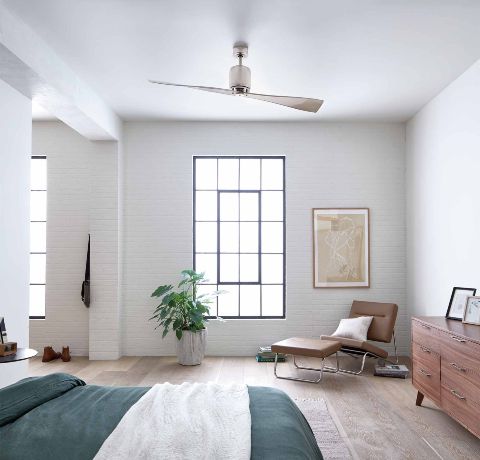Do Ceiling Fans Cool a Room?
Are you tired of feeling like you’re living in a sauna during the scorching summer months? Many homeowners struggle to stay cool while keeping energy costs down. You might question whether ceiling fans are the solution you’ve been searching for.
In this article, we’ll unravel the mysteries behind the cooling capabilities of ceiling fans. From understanding the science behind their operation to debunking common myths, we’ll equip you with the knowledge to make informed decisions about using these humble yet powerful devices. So, sit back, relax, and explore how ceiling fans can help you beat the heat while keeping cool.
Understanding How Ceiling Fans Work
Ceiling fans may seem like simple contraptions, but their inner workings hold the key to cooling your home efficiently. At their core, ceiling fans operate on a relatively straightforward principle: they move air. Mounted on the ceiling, these fans feature angled blades that rotate when powered on. As the blades spin, they create airflow circulating throughout the room.
Here’s where things get interesting. While ceiling fans don’t technically lower the temperature of a room as an air conditioner does, they can make you feel cooler. This is due to the wind chill effect, which results from the air movement generated by the fan. Ceiling fans enhance the evaporation of perspiration by creating a breeze that passes over your skin, effectively cooling your body.
Anyone who has experienced a windy day knows the concept of wind chill. Even if the air temperature remains the same, the sensation of coldness increases with a breeze. Similarly, ceiling fans create a wind chill effect indoors by continuously moving air, making you feel cooler than the temperature suggests.
While ceiling fans may not lower the room temperature per se, they facilitate the evaporation of sweat and enhance your body’s natural cooling mechanisms. So, next time you’re basking in the gentle breeze of your ceiling fan, remember that it’s not just a matter of perception—it’s science at work.
The Role of Ceiling Fans in Energy Efficiency
Ceiling fans are simple yet effective tools for keeping your home cool and comfortable. They also reduce your energy consumption and save you money. Ceiling fans don’t directly cool the air but create a wind chill effect. As air circulates across your skin, it draws away heat, making you feel cooler. This allows you to raise your thermostat setting by a few degrees without sacrificing comfort. Every degree you raise your thermostat can yield significant energy savings on your cooling bill. Here’s a breakdown of the energy consumption differences between ceiling fans and air conditioners:
- Ceiling Fans: Fans use around 1% of the electricity air conditioners consume. You could leave a fan running for 24 hours and still use less energy than 15 minutes of air conditioning.
- Air Conditioners: Generally speaking, a central air conditioner consumes between 3000 and 3500 watts per hour (compared to a ceiling fan uses about 60 watts of energy).
Therefore, strategically using ceiling fans with your air conditioner can significantly reduce your air conditioning runtime and energy consumption. Here are some tips to maximize your energy savings with ceiling fans:
- Set the right direction: During the summer, ensure your ceiling fan is rotating counterclockwise. This pushes cool air down towards you. In the winter, reverse the direction to circulate warm air trapped near the ceiling.
- Use ceiling fans strategically: Focus on using ceiling fans in occupied rooms. A ceiling fan won’t cool an empty room efficiently.
- Pair with your air conditioner: Set your thermostat slightly higher and use ceiling fans to create a comfortable breeze.
Implementing these tips can help you harness the power of ceiling fans to keep your home cool and comfortable while saving energy and money on your electricity bills.
Proper Usage of Ceiling Fans for Cooling
Ceiling fans can be a great way to beat the heat and save on energy costs, but only if used correctly. Here’s how you can maximize their cooling effect:
- Summer Cooling: During the summer, you want the cool air pushed down towards you. To achieve this, set your ceiling fan to rotate counter-clockwise. Imagine looking up at the fan; the blades should spin counter-clockwise to create a downward airflow. This creates a wind chill effect, making you feel cooler without lowering the room’s temperature.
- Finding the Sweet Spot: While a higher speed might seem ideal, it’s not always the most efficient. A medium speed provides a good balance between airflow and energy consumption. Adjust the speed based on your comfort level and the room size.
- Matching Speed to Room Size: For larger rooms, a higher speed might be necessary to circulate air effectively. In smaller rooms, a lower speed will likely suffice.
Ceiling fans work exceptionally well with air conditioning. Here’s how:
- Set your thermostat a few degrees higher (4°F is a good starting point).
- Use the ceiling fan to create a cool breeze, making the higher temperature feel comfortable.
This reduces the strain on your air conditioner, leading to lower energy usage and electricity bills. Be sure to turn off ceiling fans when a room is unoccupied; they cool people, not rooms, and running them unnecessarily wastes energy.
Debunking Common Myths About Ceiling Fans
Ceiling fans are common in many households, yet misunderstandings can result in improper use. Let’s dispel some prevalent misconceptions:
Myth #1: Ceiling Fans Lower Room Temperature
Reality: Contrary to popular belief, ceiling fans do not decrease the actual air temperature in a room. Instead, they generate a wind chill effect akin to the refreshing sensation of a breeze on a warm day. Enhancing sweat evaporation as air moves across your skin creates a sensation of coolness.
Myth #2: Idle Ceiling Fans Save Energy in Vacant Rooms
Reality: A ceiling fan serves no purpose in an empty room. Its cooling effect is directed towards individuals, not spaces. Operating a fan in an unoccupied area only results in wasted energy.
Myth #3: Ceiling Fans Function Identically Year-Round
Reality: Many ceiling fans feature a reversible motor. During summer, setting the fan to rotate counter-clockwise facilitates the downward movement of cool air. In winter, reversing its direction (clockwise) redistributes the warm air that accumulates near the ceiling, ensuring more uniform temperature distribution and potentially enabling a slight reduction in thermostat settings.
While the fan doesn’t alter the room’s actual temperature, it fosters a sense of coolness by accelerating sweat evaporation. This perceived coolness permits adjusting the thermostat higher while maintaining comfort, resulting in notable energy conservation.
Maximizing the Cooling Potential of Ceiling Fans
Ceiling fans are a pocket-friendly solution to beat the heat and trim energy costs during those sweltering summer days. But to truly harness their cooling prowess, it’s all about making savvy choices. Here’s your roadmap to getting the most out of your ceiling fan:
- Size it Right: Matching the fan’s size to the room dimensions is key. For snug spaces up to 75 square feet, a modest 28-36 inch fan will suffice. Larger areas (up to 400 square feet) demand a larger 42-52-inch fan to keep things breezy.
- Choosing the Right Type: Assess your room’s airflow requirements. Standard fans tick most boxes, but for lofty ceilings, consider snagging a downrod extension kit to optimize airflow. And if you’ve got an expansive open layout, a couple of well-placed ceiling fans might be the ticket.
- Elevate for Excellence: For prime air circulation, mount your ceiling fan, ideally 8 to 9 feet above ground level. This ensures that the cooling breeze blankets the room's inhabited areas.
- Mind the Gaps: Banish any obstacles around the fan blades that might stifle airflow. Leave at least 24 inches of breathing room between the blades and nearby walls or furniture for optimal airflow.
- Year-Round Utility: Don’t box in your ceiling fan’s talents to just the hot months. When winter rolls around, flip the blade direction (clockwise) to coax the warm air near the ceiling, potentially giving you room to nudge down that thermostat a tad.
With these insider tricks up your sleeve, your ceiling fan morphs from a mere fixture into a strategic ally in your quest for ultimate comfort and energy thriftiness at home.
Using Ceiling Fans to Cool Your Space
Ceiling fans are a simple yet powerful tool for enhancing your home’s comfort and energy efficiency. While they don’t directly lower the temperature, they create a wind chill effect that makes you feel cooler, allowing you to raise your thermostat setting and reduce your reliance on air conditioning. This translates to significant savings on your energy bills.
You can maximize the cooling potential of ceiling fans by choosing the right size and type, optimizing placement for airflow, and using them strategically with your air conditioning. Remember, ceiling fans are versatile, providing warmth distribution in the winter and cool breezes in the summer.
Ready to find the perfect ceiling fan for your home? Explore our wide selection and start saving on energy costs while keeping your home comfortable year-round!






















